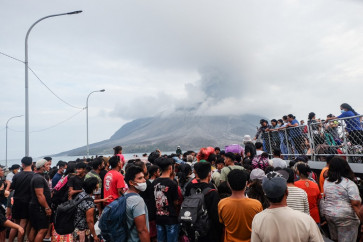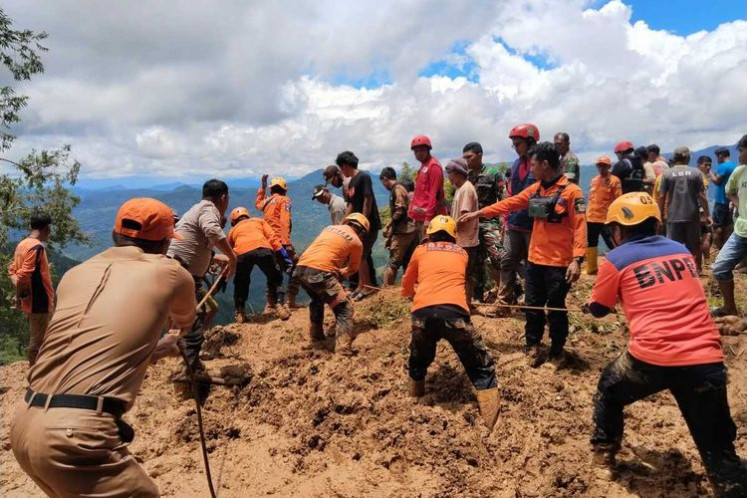A country prone to disasters and blunders
The year 2018 was likely the most disastrous year in Indonesia this decade
Change Size

T
he year 2018 was likely the most disastrous year in Indonesia this decade. Volcanos erupted spectacularly, the earth shook violently, the ground literally swallowed homes and lives, the ocean lashed angrily at our shores with two mind-numbing tsunamis.
In particular, the tsunamis have exposed fatal weaknesses in certain parts of our government.
Tsunamis have multiple causes, but they can still be identified in time to issue life-saving alerts. The final and most important empirical factor in determining a probable tsunami are tidal gauges, which measure the changes in elevation of the ocean surface.
All other measurable indications can only be considered possible contributing factors. For example, an earthquake in the sea bed might or might not set off a tsunami, depending on other factors. As would a meteorite falling into the ocean or a volcanic eruption.
A qualified monitoring team will analyze all the factors, but again, the tidal gauges are the final empirical indicator. At that point, the early warning system should kick in — whether set off automatically or initiated by competent personnel monitoring the gauges.
However, “life-saving” depends on preparation and training. There are two important aspects that have unfortunately been neglected in Indonesia. The first: although zoning laws regarding setback from the ocean are explicit, they continue to be ignored by regional authorities who are supposed to enforce them. In fact, in the case of Palu last September, not only was the setback ignored, but geologists as far back as the 1970s had given clear warnings about zones prone to liquefaction — again ignored.
The second: the need to have regular drills and training for what to do when the early warnings are actually activated, which in many places has not been effectively carried out by regional disaster mitigation agencies (BPBD).
The sole agency authorized by legislation to issue tsunami warnings is the Meteorology, Climatology and Geophysics Agency (BMKG). The BMKG answers to the President. Yet it has failed miserably in this capacity twice this year.
As is pointed out in the European Commission’s Dec. 24. 2018 report, there were tidal gauges working in the Sunda Strait and they had indicated a significant rise. Yet no prior warning was issued. Independent experts Jason R. Patton, PhD., Ross Stein, PhD and Volkan Sevilgen, MSc point out that “The tide gage record reveals that there was about 40 minutes from the first wave arrival to the highest and most destructive inundation. So, even without an expensive tsunami warning buoy system, or without a Krakatau Island seismic and GPS monitoring network, we can see, in retrospect, that warning was possible”.
It would be fair to say there was human error involved. While it is true that there were gaps in the tidal gauge network, trained personnel should be aware that a 0.91 meter rise in the sea level can translate into much higher waves as it surges through different channels and seabed formations (think Palu with its narrow bay, only months ago), not to mention volcanic activity.
The BMKG’s people said they were waiting for more comprehensive reports on Krakatau from the Center for Volcanology and Geological Hazard Mitigation (PVMBG) before they made their call. Yet tidal gauges had already registered the first abnormally high tidal movement and they were well aware of Krakatau’s heightened activity, which has been going on for months.
Even more woeful is the fact that a 2012 simulation published in the Geological Society London Special Publications predicted exactly the Krakatau flank collapse scenario that played out but seems to have been completely ignored.
In the scramble after the Palu debacle, and the recent Sunda Strait fiasco, the BMKG produced a variety of excuses as to why the early warning system (EWS) was not in effect at the actual time the tsunamis hit. The most common one was the lack of sophisticated equipment.
BMKG head Dwikorita Karnawati told the media the agency’s equipment was inadequate despite extensive potential tsunami mapping dating back to 2001. She admitted that she had failed not to warn the affected populace, but to convince the government of the urgency to procure better equipment.
There were more inconsistent statements from the BMKG head: excuses for why the tsunami alert was lifted in Palu shortly before it hit and why the early warning system was not functioning at that time; why in the Sunda Strait tragedy there was no early warning given at all in that 40 minute gap when indeed there already was data indicating abnormal ocean activity and reports from citizens about the first wave were already hitting the internet.
Then there were blunders made on social media (tweets erased and so forth), to the press — all vain attempts to distract public attention from the human failures within the agency’s operative arm.
This blame game has prompted a Gajah Mada University postgraduate lecturer, Bagas Pujilaksono Widyakanigara, to pen a strongly worded open letter (detik.com, Dec. 27, 2018) to President Jokowi, urging him to completely restructure BMKG personnel due to “their failure to grasp the situation and their total neglect of their professional responsibility to the people as public officials”. It is clearly addressed to the right person in the hierarchy, and it is very hard to disagree with the core of Bagas’ message.
In a very pointed and frankly distressing statement on TV One, Rifan Fajarsyah or Ifan Seventeen, the only survivor of the boyband Seventeen which was entertaining a party of PLN families on the beach that nightmarish night, clearly expressed his bitter disappointment with the BMKG. The tsunami killed three of his fellow band members and his wife.
He said not only had the BMKG issued their warning after the tsunami (and after his twin brother had already uploaded live a now viral video) but even then the BMKG still talked about it as a simple tidal surge. “What use is the BMKG if they not only issue the warning late, but even then they get it wrong?” he asked.
While it is true that our existing tsunami detection equipment needs replacement, the human factor is key here. What we really need is a complete restructure that puts consistent, responsive, well-trained people to man the stations, and a clear communication system. Not to mention responsible leadership of the agency.
___________________________
The author is a photographer and writer who has worked as an evacuation and relief volunteer on Mount Agung for the last 16 months.









